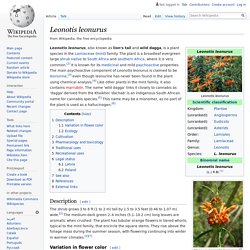

Salvia divinorum. Salvia divinorum (also known as Diviner's Sage,[2] Ska María Pastora,[3] Seer's Sage,[4] and by its genus name Salvia) is a psychoactive plant which can induce "visions" and other hallucinatory experiences.

Its native habitat is in cloud forest in the isolated Sierra Mazateca of Oaxaca, Mexico, where it grows in shady and moist locations.[5][6] The plant grows to over a meter high,[1] has hollow square stems, large leaves, and occasional white flowers with violet calyxes. Botanists have not determined whether Salvia divinorum is a cultigen or a hybrid; native plants reproduce vegetatively, rarely producing viable seed.[7][8] Mazatec shamans have a long and continuous tradition of religious use of Salvia divinorum, using it to facilitate visionary states of consciousness during spiritual healing sessions.[1] Most of the plant's local common names allude to the Mazatec belief that the plant is an incarnation of the Virgin Mary, with its ritual use also invoking that relationship. History. Psychoactive Plants. Adventures with Mazatec Mint: Exploring the Mind-Bending World of Salvia Divinorum. This article originally appeared in High Times magazine.

I would be happy to discuss the research that is presented in the article, and I welcome your questions and comments. I spent a good part of the past year working as the Guest Editor at MAPS (www.maps.org), and am very excited about all the new scientific research into psychedelic drugs. I look forward to hearing what the Reality Sandwich community thinks about my article and the future of psychedelic drug research. Within around thirty seconds of smoking the dark herbal extract the effects rapidly began, and I felt my entire sense of identity suddenly shift.
I was instantly transformed from a human being into a tiny disembodied speck of consciousness -- completely bewildered as to what I was and amnesic of my former identity. The Salvia divinorum plant is a sprawling perennial herb found in moist, isolated, and shaded regions of Oaxaca, where it grows to well over a meter in height. Salvia's Possible Medical Applications.
Leonotis leonurus. Leonotis leonurus, also known as lion's tail and wild dagga, is a plant species in the Lamiaceae (mint) family.

The plant is a broadleaf evergreen large shrub native to South Africa and southern Africa, where it is very common.[2] It is known for its medicinal and mild psychoactive properties. The main psychoactive component of Leonotis leonurus is claimed to be leonurine,[3] even though leonurine has never been found in the plant using chemical analysis.[4] Like other plants in the mint family, it also contains marrubiin. The name 'wild dagga' links it closely to cannabis as 'dagga' derived from the Khoikhoi 'dachab' is an indigenous South African name for cannabis species.[5] This name may be a misnomer, as no part of the plant is used as a hallucinogen.[6] Close-up: Leonotis leonurus flower.
Description[edit] The shrub grows 3 to 6 ft (1 to 2 m) tall by 1.5 to 3.5 feet (0.46 to 1.07 m) wide.[2] The medium-dark green 2–4 inches (5.1–10.2 cm) long leaves are aromatic when crushed.